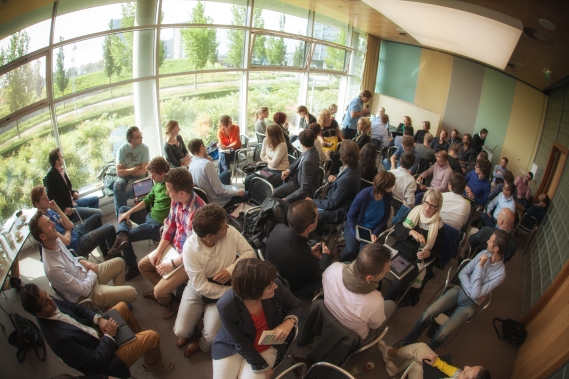In my previous post I elaborated on why Sanoma is sponsoring intrapreneurship and the role of innovation accelerators in that. This time I write about how an accelerator works at Sanoma. The approach is quite simple. It’s driven by our goals of i) developing new business lines and ii) training new skills that can be used in supporting the transformation of the core.
Talent first

Pitch training. How to explain your idea in a simple way in just one minute? Thanks for the photo Lassi.
We start by recruiting about 150 talents from across our businesses in Europe, both media and learning. In the first program, nominations were made by management. This was good but left a lot of pent-up demand. In the second program we allowed (self)-nomination, which brought an additional richness of talent.
Participants are invited to a kick-off at one of our main digital hubs: Amsterdam, Helsinki or Budapest. The main purpose of this is to inspire and excite the teams – our program leaders Lassi Kurkijärvi (Director at Sanoma) and Joris van Heukelom (Partner at Makerstreet) are truly excellent at this. People like these events a lot. We even had one aerophobic guest take the bus from Gdansk to Amsterdam to join us this Spring!
Active Learning
Next we run an intensive seven-week ideation and training program. Participants are asked to generate about ten ideas on a certain area. These ideas are further developed through an active learning experience, punctuated by a weekly webinar. They learn new skills on digital in general and “lean” development methods in particular. (I learned a lot too!) Each week there are practical assignments about building, testing and improving the ideas. The business model canvas and creating and testing minimum viable products are really useful tools on this journey. We don’t ask them to create a powerpoint deck. We ask them to test their ideas with customers. It’s liberating (not only to me).
At the end of this part of the program we select five leaders and ideas that will go to bootcamp to be built as prototypes. Selection is by a combination of the wisdom of the crowd and a Dragon’s Den. Tickets to the bootcamp are highly coveted. People get excited about it. The competitive element brings an extra edge. If you want to win, you have to compete. Your idea has to be great and you have to sell it and yourself convincingly.
Off to bootcamp
At the four day bootcamp we build working prototypes with the selected teams, together with external designers and developers. The pace is fast. It’s demanding. Customer testing continues. Energy and enthusiasm fill the room. By the end of the bootcamp we have created five prototypes. The Future Media Team of Sanoma then proposes to CEO Harri-Pekka Kaukonen, which of the concepts to turn into new ventures.
What focus? #mobileaccelerator? #contentaccelerator?
The first program, launched in Autumn last year, was the #mobileaccelerator. We see a significant shift of media consumption to mobile devices. In many cases we have been very successful in creating mobile versions of core brands. For example, about 2/3 of the usage of NU.nl, the strongest media brand in The Netherlands, is now mobile. Mobile revenues at Sanoma are growing fast. We wanted to give an additional boost to “mobilizing Sanoma”.
The second program, launched in March this year and currently running, is the #contentaccelerator. Here we are focusing on new ways of consuming content, on cross-media concepts, and on new learning content. Next week we will select the five winning concepts that will be sent to the #contentaccelerator bootcamp.
How have the accelerators performed?
Both programs have gone further and better than my best hopes. Regarding the #mobileaccelerator – we measured engagement (critical to learning) and observed that it was both broad and deep – there was at least one person from Finland, The Netherlands, Learning, Belgium, Russia and Hungary (our biggest operations) on the leaderboard top-20 for both ideas and reputation. The content and facilitation of the program have been excellent. And we came a long way in a short time – from a blank page to 5 prototypes in 10 weeks and that’s basically unheard of at Sanoma. I’m really proud of how the teams performed.
Four “mobile first” concepts have received funding as new ventures following the #mobileaccelerator. We seconded on average four people from their regular jobs to each venture for one year to take the concept to market launch. In this year they get funding and coaching. The #contentaccelerator is still underway, is going very well, but at this stage I can’t share too much about it. I daresay there will be some tweets about the bootcamp selection on Tuesday evening.
What have we learned from the accelerators so far?
On the positive side: there’s no shortage of ideas or talent or enthusiasm for innovation at Sanoma and we can move fast on innovation when we want to. From a development perspective: we sometimes have a skills gap and tools such as business model canvassing, lean development and testing MVPs, are very effective in helping to bridge the gap – we could make more use of them in the core business too. Also, we need to move faster, be more agile and to innovate closer to the customer. And we could sometimes value learning, experimentation and growth more highly and be more tolerant of risk and uncertainty. Actually, we see a lot of potential in areas where we should be able to make a positive change.
Following posting: I will share our ideas for next steps with the program.